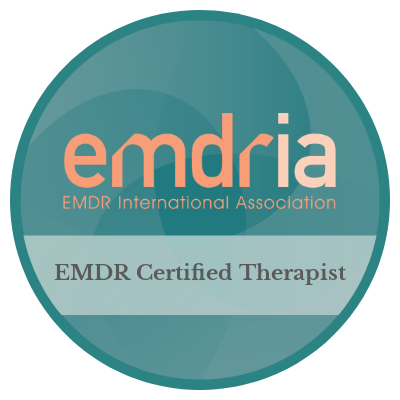My EMDR learning journey started in December 2014.....

Once upon a time, I embarked on a life-changing journey into the world of EMDR therapy. It all started in December 2014, when I stumbled upon the groundbreaking book “The Body Keeps the Score” by Dr. van der Kolk. As I delved into the pages, I was introduced to the concept of trauma and the potential for healing through Eye Movement Desensitization and Reprocessing (EMDR). The idea of EMDR fascinated me, especially after witnessing the transformation in clients before and after undergoing the therapy on the video in training. Driven by a newfound determination, I decided to enroll in EMDR training. However, for various reasons, it took me a year to kickstart my EMDR basic training in September 2015.
EMDR Trained---May 2016
The process took another year for many different reasons. Long story short, in September 2015, I started my EMDR basic training. I was sold when my trainer mentioned that many clients understand the rationales for not feeling a certain way but continue to feel the same way in the body. I remembered so many “yes…..but” conversations with many clients who felt better because I understood them, but they continued to struggle with the same symptoms because they couldn’t change the felt sense inside.
The training sessions were enlightening, and I was particularly drawn to the practical aspect of the training. I strongly believed in experiencing what I intended to guide my clients through, and the practicum provided me with that invaluable opportunity. As I completed my basic training and received my “EMDR trained” certification on May 5, 2016, I felt a sense of accomplishment, unaware that this was just the beginning of my EMDR journey.

EMDR Certified--- September 2019
After becoming “EMDR trained,” I initially assumed that I could work wonders with my newfound skills. However, reality hit me as I encountered challenges in replicating the magic of EMDR in my practice. Determined to enhance my expertise, I sought consultation and dedicated myself to further learning and development.

Over the next three years, I immersed myself in consultations, workshops, and training sessions. This period of continuous learning was both stimulating and challenging, pushing me to reevaluate my approach to trauma treatment and expand my understanding of EMDR. I found myself delving into neuropsychology and brain development, linking these areas of study to my work with trauma and PTSD.
From September 6, 2016, to September 30, 2019, I received 28 group consultations and 49 individual consultations to become a certified EMDR practitioner. Time just flew by during that time. I met up with my consultant every 2-3 weeks and attended the group consultation every two weeks between after Labor Day and Memorial Day. I also attended different training workshops whenever I could find the money to go, such as working with veterans, ego state work, Recent Traumatic Event Protocol, couples’ EMDR therapy, etc…
As I integrated EMDR into my daily practice, I honed my ability to apply the Adaptive Information Processing model, gaining deeper insights into my clients’ clinical presentations and their connections to past traumas. Understanding the importance of attachment and self-regulation in trauma treatment became a cornerstone of my approach, as I recognized the profound impact of early experiences on an individual’s ability to self-regulate.
The most essential aspects of EMDR training to me were the understanding of attachment and self-regulation in the trauma treatment process. I learned that children learn to self-regulate through the co-regulation with the caregiver. The repetition of family trauma or dysfunctional family interaction impacts the children’s ability to self-regulate because they rely on their caregivers for survival. The AIP model provides me a framework to understand how the maladaptive memories impact the client’s nervous system to self-regulate. EMDR’s eight-phase and three-pronged protocol guided me to navigate the client’s current triggers and past trauma to build a new future template via bilateral stimulation.
EMDRIA Approved Consultant --- May 2024
Upon achieving EMDRIA certification in 2019, I initially believed that I had reached the pinnacle of my journey. However, my passion for sharing my knowledge and expertise led me to pursue approved consultant status, beginning a new chapter in my EMDR journey. So, at the end of 2022, I declared my consultant-in-training (CIT) status and started another journey of “counting the hours.”
As I embarked on the path to becoming a consultant, I encountered challenges in accruing the necessary hours and refining my skills. Yet, my unwavering commitment to guiding fellow clinicians in integrating EMDR into their practices fueled my determination to gain expertise as a consultant-in-training (CIT). So, six months after I declared my CIT status, I signed up for a training program for one-year training. During my training process, I led training groups and a certification group while I continued to recruit consultees via posting on different social media.

From the beginning of my CIT training, my overarching goal as an EMDR consultant has been: “assisting the clinicians to embrace EMDR as a transformative tool and to adapt EMDR practice into their day-to-day practice.”
I did unofficial qualitative research by analyzing the postings from EMDR clinicians on a few of the EMDR Facebook communities and via my colleagues. From that process, I saw three commonly experienced EMDR clinicians, which were “overwhelmed, defeated, and uncertain.”
Throughout my CIT training, these three commonly experienced emotions continued to pop up and further validate my overarching goal as a consultant: to assist my consultees in adapting EMDR into their day-to-day practices by focusing on familiarizing them with EMDR’s three-pronged and eight-phased protocol and the AIP model.
I also experienced “overwhelmed, defeated, and uncertain” in my personal EMDR learning experiences. I started training in EMDR when I was in my mid-career. I have my theory of how people change based on the psychotherapy theories whose worldviews speak to me, from Attachment Theory, Experiential Theories (such as Gestalt, Psychodrama, and Satir’s Experiential Family Theory), Family System Theories (such as Structural Family Therapy, and Contextual Family Theory), and Human Development Theory (such as Erikson’s Theory of Human Development and Bronfenbrennier’s Ecology of Human Development). I quickly realized my difficulty in practicing EMDR lies in adapting EMDR into my day-to-day practice and incorporating EMDR into my theory of how people change. EMDR is simple but not easy because of the depth of the model. EMDR is so adaptable to clinicians who operate from different theoretical orientations. At the same time, it’s also difficult to incorporate it into different theoretical orientations due to its scripted protocol in phases 3-8.
Eight years after receiving my EMDR basic training certification, I received my approved consultant status on 5/17/2024. Throughout my CIT training journey, I have found that my experiences and language to explain EMDR and the AIP model have grown. I have also learned to explain EMDR and the AIP model using language from different theories. More importantly, I found that my EMDR clinical work experiences deepened.
As I continue to evolve on this journey, I am filled with a sense of purpose, knowing that I am making a meaningful difference in the lives of those I serve through the power of EMDR therapy. I am so grateful to have learned EMDR, and I would love to help you find joy in your EMDR learning journey.
Dr Grace Chen LMFT EMDR Training and Consultation Experiences
EMDR Training
EMDR Basic Training Offering
2024- Now, Trauma Therapist Institute (Formerly Kase & Co) Training Faculty.
Presentation
Chen, C. G. (2025), The Marriage of EMDR Therapy and Couples Therapy Through the Lens of Polyvagal Theory. Presented at Western Mass EMDR Network 18th Conference.
EMDR Advanced Training
I offer individual and group consultation.
Contact me:
Phone: 978-482-7480
Email: [email protected]
Fill out the form next to this column
